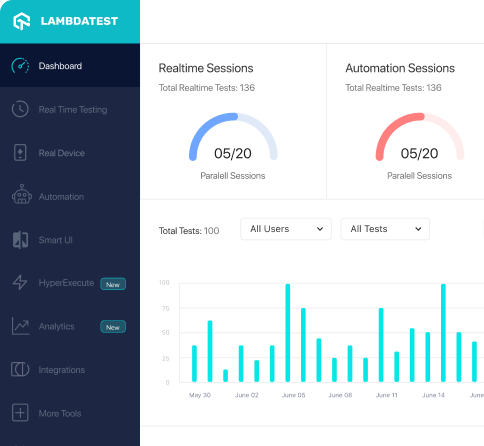How to use StandardRepresentation_iterable_format_Test class of org.assertj.core.presentation package
Best Assertj code snippet using org.assertj.core.presentation.StandardRepresentation_iterable_format_Test
...15import java.util.Arrays;16import java.util.List;17import org.assertj.core.api.Assertions;18import org.junit.jupiter.api.Test;19public class StandardRepresentation_iterable_format_Test extends AbstractBaseRepresentationTest {20 private static final StandardRepresentation STANDARD_REPRESENTATION = new StandardRepresentation();21 @Test22 public void should_return_null_if_iterable_is_null() {23 Assertions.assertThat(StandardRepresentation_iterable_format_Test.STANDARD_REPRESENTATION.smartFormat(((Iterable<?>) (null)))).isNull();24 }25 @Test26 public void should_return_empty_brackets_if_iterable_is_empty() {27 Assertions.assertThat(StandardRepresentation_iterable_format_Test.STANDARD_REPRESENTATION.smartFormat(Arrays.asList())).isEqualTo("[]");28 }29 @Test30 public void should_format_iterable_on_one_line_if_description_is_short_enough() {31 String e1 = StandardRepresentation_iterable_format_Test.stringOfLength(((StandardRepresentation.getMaxLengthForSingleLineDescription()) / 10));32 String e2 = StandardRepresentation_iterable_format_Test.stringOfLength(((StandardRepresentation.getMaxLengthForSingleLineDescription()) / 10));33 Assertions.assertThat(StandardRepresentation_iterable_format_Test.STANDARD_REPRESENTATION.smartFormat(Arrays.asList(e1, e2))).isEqualTo((((("[\"" + e1) + "\", \"") + e2) + "\"]"));34 }35 @Test36 public void should_format_iterable_with_one_element_per_line_when_single_line_description_is_too_long() {37 String e1 = StandardRepresentation_iterable_format_Test.stringOfLength(StandardRepresentation.getMaxLengthForSingleLineDescription());38 String e2 = StandardRepresentation_iterable_format_Test.stringOfLength(StandardRepresentation.getMaxLengthForSingleLineDescription());39 Assertions.assertThat(StandardRepresentation_iterable_format_Test.STANDARD_REPRESENTATION.smartFormat(Arrays.asList(e1, e2))).isEqualTo(String.format(((((("[\"" + e1) + "\",%n") + " \"") + e2) + "\"]")));40 }41 @Test42 public void should_format_iterable_with_custom_start_and_end() {43 List<? extends Object> list = Arrays.asList("First", 3);44 Assertions.assertThat(StandardRepresentation_iterable_format_Test.STANDARD_REPRESENTATION.singleLineFormat(list, "{", "}")).isEqualTo("{\"First\", 3}");45 Assertions.assertThat(StandardRepresentation_iterable_format_Test.STANDARD_REPRESENTATION.singleLineFormat(Arrays.asList(), "{", "}")).isEqualTo("{}");46 }47 @Test48 public void should_format_iterable_with_one_element_per_line() {49 String formatted = StandardRepresentation_iterable_format_Test.STANDARD_REPRESENTATION.multiLineFormat(Arrays.asList("First", 3, "foo", "bar"));50 String formattedAfterNewLine = (((System.lineSeparator()) + " <") + formatted) + ">";51 Assertions.assertThat(formattedAfterNewLine).isEqualTo(String.format(("%n" + (((" <[\"First\",%n" + " 3,%n") + " \"foo\",%n") + " \"bar\"]>"))));52 }53 @Test54 public void should_format_iterable_up_to_the_maximum_allowed_elements_multi_line() {55 StandardRepresentation.setMaxElementsForPrinting(3);56 StandardRepresentation.setMaxLengthForSingleLineDescription(10);57 String formatted = StandardRepresentation_iterable_format_Test.STANDARD_REPRESENTATION.smartFormat(Arrays.asList("First", 3, "foo", "bar"));58 String formattedAfterNewLine = (((System.lineSeparator()) + " <") + formatted) + ">";59 Assertions.assertThat(formattedAfterNewLine).isEqualTo(String.format(("%n" + (((" <[\"First\",%n" + " 3,%n") + " \"foo\",%n") + " ...]>"))));60 }61 @Test62 public void should_format_iterable_up_to_the_maximum_allowed_elements_single_line() {63 StandardRepresentation.setMaxElementsForPrinting(3);64 String formatted = StandardRepresentation_iterable_format_Test.STANDARD_REPRESENTATION.smartFormat(Arrays.asList("First", 3, "foo", "bar"));65 Assertions.assertThat(formatted).isEqualTo("[\"First\", 3, \"foo\", ...]");66 }67 @Test68 public void should_format_iterable_with_an_element_per_line_according_the_given_representation() {69 String formatted = new HexadecimalRepresentation().multiLineFormat(Arrays.asList(1, 2, 3));70 String formattedAfterNewLine = (((System.lineSeparator()) + " <") + formatted) + ">";71 Assertions.assertThat(formattedAfterNewLine).isEqualTo(String.format(("%n" + ((" <[0x0000_0001,%n" + " 0x0000_0002,%n") + " 0x0000_0003]>"))));72 }73 @Test74 public void should_format_recursive_iterable() {75 List<Object> list = new ArrayList<>();76 list.add(list);77 list.add(list);78 String formatted = StandardRepresentation_iterable_format_Test.STANDARD_REPRESENTATION.multiLineFormat(list);79 Assertions.assertThat(formatted).isEqualTo(String.format(("[(this Collection),%n" + " (this Collection)]")));80 }81}...StandardRepresentation_iterable_format_Test
Using AI Code Generation
1import org.assertj.core.api.Assertions;2import org.assertj.core.presentation.StandardRepresentation;3import org.junit.Test;4public class StandardRepresentation_iterable_format_Test {5 private StandardRepresentation standardRepresentation = new StandardRepresentation();6 public void should_format_iterable() {7 Assertions.assertThat(standardRepresentation.iterableFormat("[a, b, c]")).isEqualTo("[a, b, c]");8 }9}10org.assertj.core.api.Assertions.assertThat(standardRepresentation.iterableFormat("[a, b, c]")).isEqualTo("[a, b, c]");11org.assertj.core.api.Assertions.assertThat(standardRepresentation.iterableFormat("[a, b, c]")).isEqualTo("[a, b, c]");StandardRepresentation_iterable_format_Test
Using AI Code Generation
1import static org.assertj.core.api.Assertions.assertThat;2import java.util.ArrayList;3import java.util.List;4import org.assertj.core.presentation.StandardRepresentation;5import org.junit.Test;6public class StandardRepresentation_iterable_format_Test {7 private final StandardRepresentation standardRepresentation = new StandardRepresentation();8 public void should_return_string_representation_of_iterable() {9 List<String> list = new ArrayList<>();10 list.add("foo");11 list.add("bar");12 assertThat(standardRepresentation.iterableFormat(list)).isEqualTo("[foo, bar]");13 }14}15OK (1 test)StandardRepresentation_iterable_format_Test
Using AI Code Generation
1package org.assertj.core.presentation;2import static org.assertj.core.api.Assertions.assertThat;3import java.util.Arrays;4import java.util.List;5import org.junit.jupiter.api.Test;6import org.junit.jupiter.params.ParameterizedTest;7import org.junit.jupiter.params.provider.MethodSource;8class StandardRepresentation_iterable_format_Test {9 static List<Object[]> iterableFormatProvider() {10 return Arrays.asList(new Object[][] {11 { Arrays.asList(1, 2, 3), "[1, 2, 3]" },12 { Arrays.asList(1, 2, 3, 4, 5), "[1, 2, 3, 4, 5]" },13 { Arrays.asList(1, 2, 3, 4, 5, 6, 7), "[1, 2, 3, 4, 5, 6, 7]" },14 { Arrays.asList(1, 2, 3, 4, 5, 6, 7, 8, 9), "[1, 2, 3, 4, 5, 6, 7, 8, 9]" },15 { Arrays.asList(1, 2, 3, 4, 5, 6, 7, 8, 9, 10), "[1, 2, 3, 4, 5, 6, 7, 8, 9, 10]" },16 { Arrays.asList(1, 2, 3, 4, 5, 6, 7, 8, 9, 10, 11), "[1, 2, 3, 4, 5, 6, 7, 8, 9, 10, 11]" },17 { Arrays.asList(1, 2, 3, 4, 5, 6, 7, 8, 9, 10, 11, 12), "[1, 2, 3, 4, 5, 6, 7, 8, 9, 10, 11, 12]" },18 { Arrays.asList(1, 2, 3, 4, 5, 6, 7, 8StandardRepresentation_iterable_format_Test
Using AI Code Generation
1import org.assertj.core.presentation.StandardRepresentation_iterable_format_Test;2import org.assertj.core.api.Assertions;3import org.assertj.core.util.Lists;4import org.junit.Test;5import java.util.ArrayList;6import java.util.List;7public class StandardRepresentation_iterable_format_TestTest {8 public void test_format() {9 StandardRepresentation_iterable_format_Test iterable_format_Test = new StandardRepresentation_iterable_format_Test();10 List<String> list = new ArrayList<>();11 list.add("foo");12 list.add("bar");13 String string = iterable_format_Test.format(list);14 Assertions.assertThat(string).isEqualTo("[\"foo\", \"bar\"]");15 }16}17package org.assertj.core.presentation;18import org.assertj.core.util.Lists;19import org.assertj.core.util.Sets;20import org.junit.Test;21import java.util.List;22import java.util.Set;23import static org.assertj.core.api.Assertions.assertThat;24public class StandardRepresentation_iterable_format_Test {25 public void should_format_iterable() {26 StandardRepresentation representation = new StandardRepresentation();27 List<String> list = Lists.newArrayList("foo", "bar");28 assertThat(representation.iterableFormat(list)).isEqualTo("[\"foo\", \"bar\"]");29 }30 public void should_format_empty_iterable() {31 StandardRepresentation representation = new StandardRepresentation();32 List<String> list = Lists.newArrayList();33 assertThat(representation.iterableFormat(list)).isEqualTo("[]");34 }35 public void should_format_set() {36 StandardRepresentation representation = new StandardRepresentation();37 Set<String> set = Sets.newLinkedHashSet("foo", "bar");38 assertThat(representation.iterableFormat(set)).isEqualTo("[\"foo\", \"bar\"]");39 }40 public void should_format_empty_set() {41 StandardRepresentation representation = new StandardRepresentation();42 Set<String> set = Sets.newLinkedHashSet();43 assertThat(representation.iterableFormat(set)).isEqualTo("[]");44 }45}46package org.assertj.core.presentation;47import org.assertj.core.util.*;48import java.util.*;49import static org.assertj.core.util.Arrays.array;50 * This representation is used by default in {@link org.assertj.core.api.AbstractAssert} and51 * It is also used when comparing objects with {@link org.assertj.core.api.Assertions#assertBlogs
Check out the latest blogs from LambdaTest on this topic:
Automation frameworks enable automation testers by simplifying the test development and execution activities. A typical automation framework provides an environment for executing test plans and generating repeatable output. They are specialized tools that assist you in your everyday test automation tasks. Whether it is a test runner, an action recording tool, or a web testing tool, it is there to remove all the hard work from building test scripts and leave you with more time to do quality checks. Test Automation is a proven, cost-effective approach to improving software development. Therefore, choosing the best test automation framework can prove crucial to your test results and QA timeframes.
Software testing is fueling the IT sector forward by scaling up the test process and continuous product delivery. Currently, this profession is in huge demand, as it needs certified testers with expertise in automation testing. When it comes to outsourcing software testing jobs, whether it’s an IT company or an individual customer, they all look for accredited professionals. That’s why having an software testing certification has become the need of the hour for the folks interested in the test automation field. A well-known certificate issued by an authorized institute kind vouches that the certificate holder is skilled in a specific technology.
This article is a part of our Content Hub. For more in-depth resources, check out our content hub on Mobile App Testing Tutorial.
In today’s data-driven world, the ability to access and analyze large amounts of data can give researchers, businesses & organizations a competitive edge. One of the most important & free sources of this data is the Internet, which can be accessed and mined through web scraping.
Automation Testing Tutorials
Learn to execute automation testing from scratch with LambdaTest Learning Hub. Right from setting up the prerequisites to run your first automation test, to following best practices and diving deeper into advanced test scenarios. LambdaTest Learning Hubs compile a list of step-by-step guides to help you be proficient with different test automation frameworks i.e. Selenium, Cypress, TestNG etc.
LambdaTest Learning Hubs:
- JUnit Tutorial
- TestNG Tutorial
- Webdriver Tutorial
- WebDriverIO Tutorial
- Protractor Tutorial
- Selenium 4 Tutorial
- Jenkins Tutorial
- NUnit Tutorial
- Jest Tutorial
- Playwright Tutorial
- Cypress Tutorial
- PyTest Tutorial
YouTube
You could also refer to video tutorials over LambdaTest YouTube channel to get step by step demonstration from industry experts.
Most used methods in StandardRepresentation_iterable_format_Test
Try LambdaTest Now !!
Get 100 minutes of automation test minutes FREE!!




